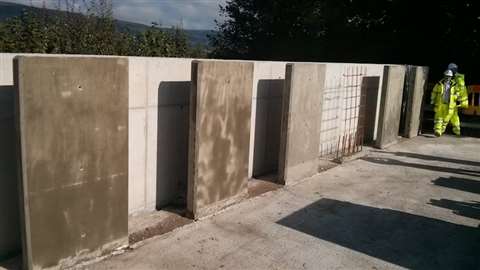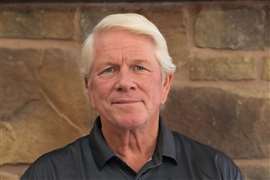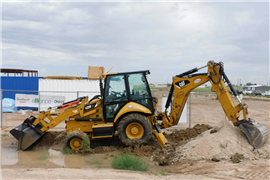Will self-healing concrete ever play a significant role in construction?
27 March 2023
 Crumbling concrete piers on a bridge expose steel reinforcements to corrosion (Image: James via Adobe Stock stock.adobe.com)
Crumbling concrete piers on a bridge expose steel reinforcements to corrosion (Image: James via Adobe Stock stock.adobe.com)
Self-healing concrete promises to revolutionise the maintenance of concrete structures, slashing repair bills by filling cracks as they form.
While plenty of research is going into the technology so far its use in real-world projects remains limited.
But following recent advances in the technology and research projects around the world, could that be about to change?
What form might the technology take and what uses could it have?
And how long before self-healing concrete starts to play a significant role in construction?
Different self-healing concrete techniques
There are four main different techniques to promote self-healing in concrete:
- Capsules: Capsules containing various healing agents can be added to concrete mixes. As cracks in the concrete form, the capsules rupture to release the healing agents, sealing the cracks back up. The capsules can be made from materials like gelatine that dissolve to release materials like sodium silicate. Sodium silicate reacts with calcium hydroxide in water. Together, they form a calcium silicate hydrate gel, which is the main product of cement hydration. One disadvantage of the technique is that once the capsules have ruptured, the concrete can’t self-heal further.
- Bacteria: Concrete can be mixed with certain types of dormant bacteria infused into aggregate particles, along with nutrients. As cracks form and water penetrates the concrete, the nutrients dissolve. They provide a food source for the bacteria, causing them to produce calcium carbonate to fill the cracks.
- Shape memory polymers: Shape memory polymers can be built into the concrete in small channels or tied onto reinforcements within it. As the concrete cracks and the polymers stretch, a heating wire system causes them to contract again and pull the structure back into shape.
- Vascular: Artificially created channels in the concrete allow pumps to pump healing agents into the concrete as it becomes damaged, sealing the cracks back up. While in earlier iterations, this involved placing pumps on the outside of the structure to pump the healing agents in, researchers have moved on to more advanced mini vascular networks. These assume the form of 3D-printed tetrahedral units with hollow ligaments. They store, protect and release bacterial healing agents when mechanical stresses in the concrete pass a certain threshold.
There are still only a few companies, like Basilisk in the Netherlands, offering self-healing concrete commercially.
But that could be set to change as the technology advances. Kevin Paine, professor of infrastructure materials at the University of Bath, has been involved in self-healing concrete for around a decade. That has been through two UK-funded projects called Materials for Life and Resilient Materials for Life. The programmes also involve the universities of Cardiff, Cambridge and Bradford. Prof. Paine specialises in encapsulating different types of bacteria.
He says, “We are at a stage where the main technologies are now advanced and there is no reason why they can’t be used in construction. The question is, can they be scaled up?”
Applications of self-healing concrete
Regardless of the techniques, self-healing concrete is generally only capable of sealing cracks up to 1mm in width. While that doesn’t sound significant, it makes the technology useful in prolonging the life of structures.
Prof. Paine explains: “The beauty of self-healing concrete is that you are trying to repair cracks that you wouldn’t normally repair because they are too small. With normal concrete, you have to wait for the repair to get quite large before you can do anything about it. Whereas self-healing concrete can sort problems before they even emerge.
 The Materials for Life project tested different self-healing concrete techniques on Costain’s Heads of the Valleys project in Wales. (Image courtesy of Cardiff University)
The Materials for Life project tested different self-healing concrete techniques on Costain’s Heads of the Valleys project in Wales. (Image courtesy of Cardiff University)
“We often to talk about this as being biomimetic, so talking about something that the human body does. The human body is very good at healing thin cuts. But if you completely slash yourself open, you are going to need someone to repair it for you – and it is the same with concrete. The self-healing works at a particular scale.”
He expects self-healing concrete to be particularly useful for water-retaining structures, where a crack of any size is bad news. “In that scenario, you have to design the concrete so that if a crack happens, it won’t get very large, which means you need to have a lot of reinforcement. With self-healing concrete, that crack will fill itself, which means you can save a lot on steel,” he says.
Bridges, which are also exposed to significant amounts of moisture, are another area where he sees potential. Maintenance is costly and results in downtime where the bridge can’t be used.
Meanwhile, sustainable engineering expert Professor Yan Zhuge at the University of South Australia UNISA), is developing a self-healing concrete solution for sewer pipes. Acid from sulphur-oxidising bacteria in wastewater, along with excessive loads and temperature fluctuations crack pipes. Prof. Zhuge is working on microcapsules filled with alum sludge – a by-product of wastewater treatment plants – and calcium hydroxide powder as healing agents. The University estimates that the solution could save AUS $1.4 billion in annual maintenance costs.
Will self-healing concrete ever become widespread?
Prof. Zhuge estimates that it will be another decade before self-healing concrete is commonly used in commercial applications. Meanwhile, her own project three-years away from completion.
But Prof. Paine is already confident that the technology he and his colleagues in the UK have been working on is ready. He is now looking to scale-up in partnership with biotech firms and companies that produce admixtures.
“We have got bacteria that we think are better than bacteria used elsewhere. We know they work, we just need to find companies that can produce kilogrammes of spores, rather than the grammes we can produce. There are construction companies out there that would like to try it and get demonstrator projects going,” he says.
Nonetheless, there are hurdles to overcome before its widespread adoption. As with all new products, it will need businesses to use it successfully before others will do the same. And it will also require the development of new standards.
Beyond that, construction professionals will need to learn to balance concrete’s self-healing properties with the amount of reinforcement they include in structures. “I don’t think any engineer has a particular problem adding a self-healing component to concrete. But they may feel more afraid of optimising concrete because it is self-healing. They may have concerns about removing reinforcements and they are going to want guidance and codes of practice on how much they can take out,” he says.
But longer term, he thinks self-healing concrete will become ubiquitous in certain applications.
He concludes, “People will probably stop talking about it as self-healing concrete. It will just become concrete that has a certain admixture in it. People don’t really talk about waterproof concrete anymore. Concrete used in basements is just expected to have waterproofing admixture added to it. In the future, no-one will think too much about having a self-healing element added to concrete. It will become a standard.”
STAY CONNECTED



Receive the information you need when you need it through our world-leading magazines, newsletters and daily briefings.
CONNECT WITH THE TEAM












